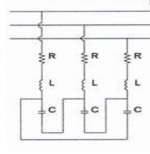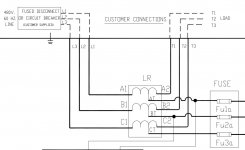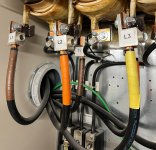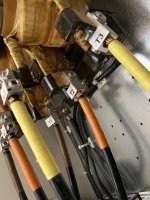MiketheSparky
Member
- Location
- Seattle
- Occupation
- Electrician
Hello all,
First time poster here. I have a situation where my customer has asked that I find some independent information about what happens to the electrical system/harmonic filter mitigation when they have issues with their filters.
Backstory: Harmonic filters were installed per the contracted engineering firm after the equipment was installed. There are 45 filters throughout the building ranging from 15A 480V to 800A 480v. Since their installation, there have been multiple issues with contactors and fuse blocks creating arc faults. After finding manufacturing issues and having them corrected (properly torqued factory connections), I performed an IR scan of the building and found 10+ filters that had phase imbalances. Upon troubleshooting I discovered that all phase imbalances were on filters that had 1 blown fuse after the primary reactor.
My understanding of the filters is that the harmonics enter on 1 phase and leave on the other 2. (Correct me if I am wrong on that one.) So if there was a blown fuse then the harmonics would stack up on a single phase? If 2 fuses are blown then there is no filtering coming from the tuned reactor because it would just phase out correct?
What are the impacts to the electrical system in each scenario? The customer wants to remove all harmonic mitigation from their system due to the amount of money already spent in correcting the issues from the manufacturer. Do we have a good case to remove them? They are all on VFD's from air handlers and pump motors and they are all on a generator backed distribution. Thanks for your time.
First time poster here. I have a situation where my customer has asked that I find some independent information about what happens to the electrical system/harmonic filter mitigation when they have issues with their filters.
Backstory: Harmonic filters were installed per the contracted engineering firm after the equipment was installed. There are 45 filters throughout the building ranging from 15A 480V to 800A 480v. Since their installation, there have been multiple issues with contactors and fuse blocks creating arc faults. After finding manufacturing issues and having them corrected (properly torqued factory connections), I performed an IR scan of the building and found 10+ filters that had phase imbalances. Upon troubleshooting I discovered that all phase imbalances were on filters that had 1 blown fuse after the primary reactor.
My understanding of the filters is that the harmonics enter on 1 phase and leave on the other 2. (Correct me if I am wrong on that one.) So if there was a blown fuse then the harmonics would stack up on a single phase? If 2 fuses are blown then there is no filtering coming from the tuned reactor because it would just phase out correct?
What are the impacts to the electrical system in each scenario? The customer wants to remove all harmonic mitigation from their system due to the amount of money already spent in correcting the issues from the manufacturer. Do we have a good case to remove them? They are all on VFD's from air handlers and pump motors and they are all on a generator backed distribution. Thanks for your time.






